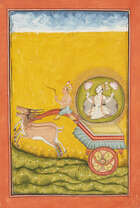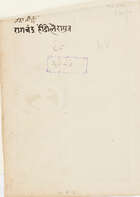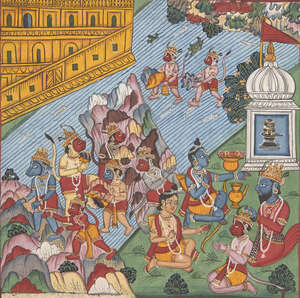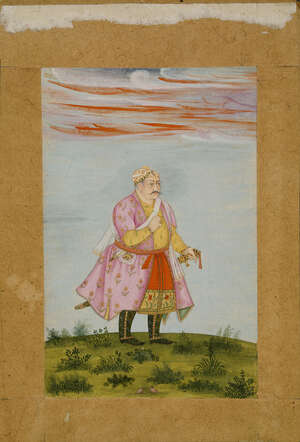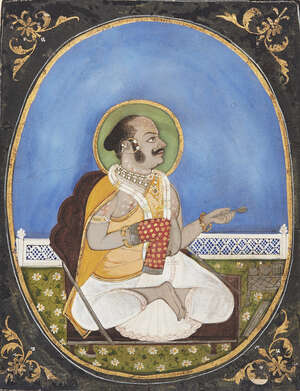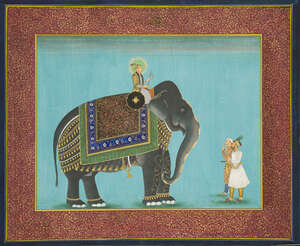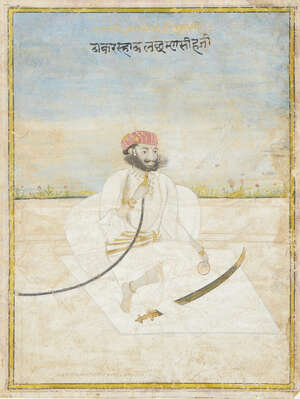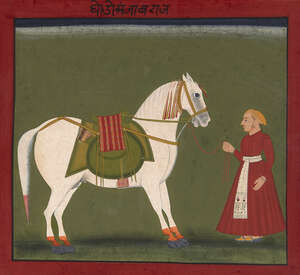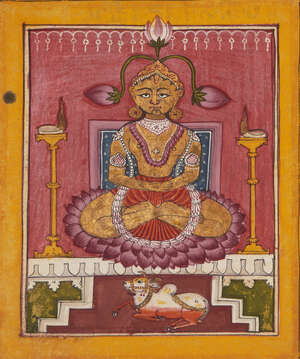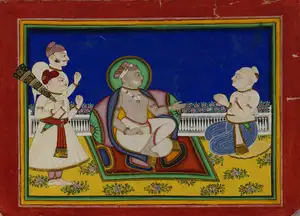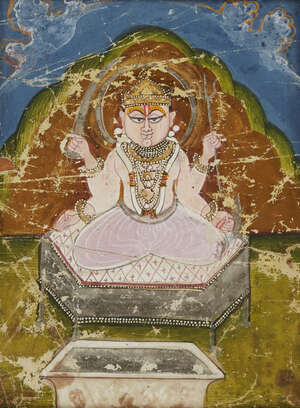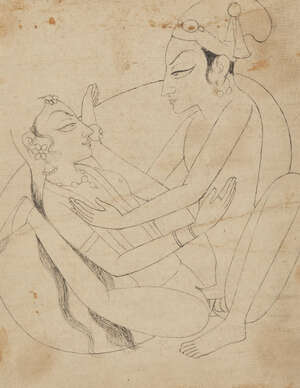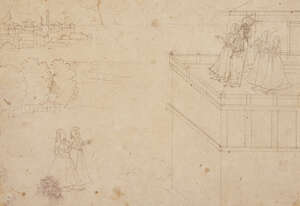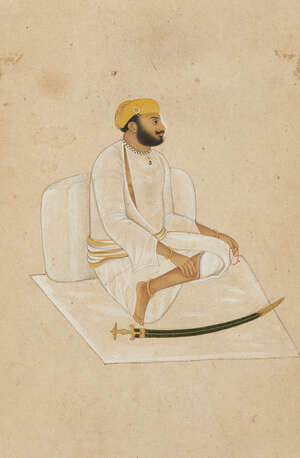Wednesday 17 June 2020
An illustration to a Ragamala series, Chandra Ragaputra, son of Hindola by a Pahari...
View MoreLot 173
Description
An illustration to a Ragamala series, Chandra Ragaputra, son of Hindola by a Pahari artist, Chamba or Bilaspur, Punjab Hills, North India, early 18th century, opaque watercolour and gold on paper, with a vivid red border, painting 18.9 x 12 cm., with red border 21.6 x 14.8cm.
Provenance
Private Collection, Germany
Inscribed on reverse in takri characters: raga candra // hindole 3 and raga candra and in nagari: raga candra hindole da putra (Candra raga [third] son of Hindola) as well as numbers 68 and 2484 within a cartouche, the last being the Mandi royal inventory number.
Candra, the moon god, crowned and holding two lotuses, is seated within his radiant orb on a chariot being drawn by two deer, with a charioteer crouched on the shaft with a whip. The ground beneath the chariot is carefully depicted composed of green ridges, their crests marked by darker streaks of green, on which grow clumps of red and white flowers with spiky green leaves. The Pahari artists of ragamalas followed Mesakarnas system which has six main ragas normally each with five wives or raginis and eight sons or ragaputras. The iconography of each painting is meant to embody both the descriptions of the raga as well as the sound with which it can be compared (Ebeling 1973, p. 64). In fact the artists often went their own ways, for Mesakarnas Candra son of Hindola is meant to have the iconography of a man dressed in lotus leaves and evoke the sound of a muskrat (ibid., p. 74).
This painting is f.68 from a dispersed album that was once in the Mandi royal collection. Pages from the album are now scattered in various public and private collections. Cathy Glynn has traced the albums presence from its inscriptions in the Kangra royal library of the Maharani Odaroli, but some time afterwards it was moved to Mandi where it was rebound in 1841 (Glynn, Skelton and Dallapiccola 2011, pp. 34-36). Most of the paintings are of typical Hindu/Rajput subjects such as Ragas, Raginis and Ragaputras belonging to the Pahari system of musical modes, as well as avatars of Vishnu and other deities. Though clearly the product of a single studio in the Punjab Hills, they are nonetheless probably the work of artists trained in more than one tradition. The style of painting dates from the beginning of the eighteenth century. Normally the page is divided into three major areas: a narrow strip at the bottom for the ground, a strip of white and blue with tangled clouds at the top, and a larger central area which the tall and vigorous figures almost fill against a solid ground. The most surprising element in these paintings is the influence of Deccani painting, evident in the striking but cool palette of lilac, mauve and turquoise, compositional ingenuity and strong element of fantasy (see Seyller 2011). While still displaying the vigorous line associated with early Pahari painting, the artists are also aware of Mughal or perhaps Deccani practices in their approach to shading and volume and the rendition of textiles.
Glynn believes the album was actually prepared in Chamba 1690-1700 on account of a similarity in the hanging fold of the turban over the neck found occasionally in Chamba as in a wood carving of c. 1650 (Glynn op. cit., pp. 34-35). However, there are close resemblances in the iconography of this series with later ragamala paintings from Bilaspur, where earlier publications placed the album. Bilaspur was one of the few Pahari states to produce vertical Ragamalas at this date, so the precise provenance remains for the moment open.
Literature
Archer, W.G., Indian Paintings from the Punjab Hills, Sotheby Parke Bernet, London, 1973
Ebeling, K., Ragamala Painting, Ravi Kumar, Basel, 1973
Glynn, C., Skelton, R., and Dallapiccola, A., Ragamala Paintings from India from the Claudio Moscatelli Collection, Philip Wilson, London, 2011
Goswamy, B.N., and Fischer, E., Pahari Masters: Court Painters of Northern India, Oxford University Press, Delhi, 1992
Seyller, J., Deccani Elements in Early Pahari Painting in Haidar, N., and Sardar, M., eds., Sultans of the South: Arts of Indias Deccan Courts, 1323-1687, Metropolitan Museum, New York, 2011, pp. 64-81
Fees & VAT
Buyer's Premium
The buyer shall pay the hammer price together with a premium thereon of 26% up to £20,000 (31.2% inclusive of VAT), 25% from £20,001 - £500,000 (30% inclusive of VAT), 20% from £500,001 thereafter (24% inclusive of VAT). The premium price is subject to VAT at the standard rate.
VAT
VAT is not charged on the hammer price unless it is stated that there is 'VAT applicable on the hammer price at the end of the description. Buyer's premium is subject to VAT.(ARR) - ARTIST'S RESALE RIGHT
Qualifying living artists and the descendants of artists deceased within the last 70 years are entitled to receive a re-sale royalty each time their work is bought through an auction house or art market professional.
It applies to lots with hammer value over £1,000 as follows:
0 to £50,000 - 4%
£50,000.01 to £200,000 - 3%
£200,000.01 to £350,000 - 1%
£350,000.01 to £500,000 - 0.5%
Exceeding £500,000 - 0.25%
ARR is capped at £12,500
Please note ARR is calculated in euros. Auctioneers will apply current exchange rates.
Export of goods
Buyers intending to export goods should ascertain whether an export licence is required before bidding. Export licences are issued by Arts Council England and application forms can be obtained from its Export Licensing Unit. Details can be found on the ACE website www.artscouncil.org.uk or by phoning ACE on 020 7973 5188. The need for import licences varies from country to country and you should acquaint yourself with all relevant local requirements and provisions before bidding. The refusal of any such licences shall not permit the cancelling of any sale nor allow any delay in making full payment for the lot.
Own a similar item?
Request a ValuationReceive alerts about similar lots
Get StartedContinue Browsing
LOT 174
A maiden dancing on a palace terrace, a vivid sunset behind her, Guler, India, circa 1790
Estimate: £2000 - £3000
LOT 175
Hanuman and worshippers with shrine, Kulu school, 19th century, opaque pigments on paper,...
Estimate: £800 - £1200
LOT 176
Two fakirs on a terrace, Hyderabad, 19th century, opaque pigments on paper heightened...
Estimate: £200 - £300
LOT 177
Raja Udai Singh (Mota Raja) of Marwar, Rajasthan, North India, early 19th century, opaque...
Estimate: £400 - £600
LOT 178
A seated Gosain (Holy man) of the Vallabhalarya sect of Vaishnavite Hindus, Nathadwara,...
Estimate: £400 - £600
LOT 179
Three Jain paintings on wood, Jaipur school, late 18th-early 19th century, gouache...
Estimate: £800 - £1200
LOT 180
A Mughal noble and his elephant, India, 20th century, opaque pigments on paper, a haloed...
Estimate: £300 - £500
LOT 181
A seated portrait of Thakur Lakshman Singh smoking, India, 19th century, opaque pigments...
Estimate: £500 - £600
LOT 182
Two equestrian portraits, Mewar, 19th century, opaque pigments on paper heightened with...
Estimate: £800 - £1200
LOT 183
Rishabhanatha (Adinatha), the first of the 24 Tirtahankaras in Jain cosmology, gouache on...
Estimate: £100 - £200
LOT 184
A ruler seated, Jodhpur, India, 19th century, gouache on paper heightened with gilt, with...
Estimate: £300 - £500
LOT 185
A Jain Tirthankara painting, West India, circa 1790, opaque pigments heightened with gilt...
Estimate: £80 - £120
LOT 186
A drawing of an erotic embrace, Kishangarh, Rajasthan, India, 18th century, ink on paper,...
Estimate: £300 - £500
LOT 187
The elephant Garhe Rao with his rider Nura, Kishangargh, Rajasthan, North West India,...
Estimate: £5000 - £7000
LOT 188
A drawing of Krishna and Radha on a terrace, Jaipur, India, circa 1800, graphite on dark...
Estimate: £1200 - £1500
LOT 189
Portrait of a seated man with a sword, Delhi, circa 1840, opaque watercolour on paper...
Estimate: £800 - £1200
 Newsletter Signup
Newsletter Signup
 Keyword Alerts
Keyword Alerts
Would you like to receive personalised keyword alerts when new catalogues go live. If so, please indicate these below
Set a password to save your keyword alerts
Passwords are a minimum of 7 characters and must include an upper case letter, a lower case letter, a number and a special character (e.g., !@#$%^&*).


